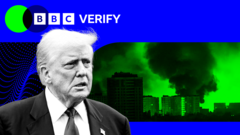As President Trump attempts to negotiate a ceasefire, Ukrainian forces face unprecedented aerial bombardment from Russia. According to a recent study, military intelligence indicates that since Trump's inauguration, the number of attacks from Russia has surged sharply, reversing brief periods of decreased violence previously seen during the Biden administration.
The issue escalated following Trump's campaign promise to halt the conflict in Ukraine, claiming he could achieve peace in just one day. However, as attacks surged to the highest levels seen throughout the war, critics have pointed to moments where Trump's policies may have inadvertently strengthened Russian aggression.
Since January 20, recorded incidents show that Russia launched over 27,000 military munitions against Ukraine as compared to around 11,600 in the latter half of President Biden's term, raising alarms among Ukrainian officials. Trump’s administration has also paused military aid deliveries to Ukraine twice this year, raising questions about its commitment to supporting the country as Russian military capabilities expand significantly.
In stark contrast to earlier negotiations, where initial reductions in attacks were observed, the situation intensified after U.S. diplomats led by Secretary of State Marco Rubio engaged with Russian officials in Riyadh. These talks aimed to foster dialogue, yet have so far resulted in backlash rather than peace. Reports indicate a major spike in Russian drone and missile production, undermining Ukraine’s defensive efforts.
The continuing escalation in attacks prompts urgent calls from U.S. lawmakers for increased military support to Ukraine. Senator Chris Coons emphasized that Trump's leadership should project strength to deter further Russian aggression. The rising number of attacks has affected civilian lives dramatically, instilling a sense of continuous dread among residents in Ukraine.
As Trump aims for a truce, his approach faces scrutiny with rising tensions and an illusive sense of security for the Ukrainian people. With no clear resolution in sight, the conflict continues to exact pressure on Ukraine's defensive capabilities and the morale of its citizens.
The issue escalated following Trump's campaign promise to halt the conflict in Ukraine, claiming he could achieve peace in just one day. However, as attacks surged to the highest levels seen throughout the war, critics have pointed to moments where Trump's policies may have inadvertently strengthened Russian aggression.
Since January 20, recorded incidents show that Russia launched over 27,000 military munitions against Ukraine as compared to around 11,600 in the latter half of President Biden's term, raising alarms among Ukrainian officials. Trump’s administration has also paused military aid deliveries to Ukraine twice this year, raising questions about its commitment to supporting the country as Russian military capabilities expand significantly.
In stark contrast to earlier negotiations, where initial reductions in attacks were observed, the situation intensified after U.S. diplomats led by Secretary of State Marco Rubio engaged with Russian officials in Riyadh. These talks aimed to foster dialogue, yet have so far resulted in backlash rather than peace. Reports indicate a major spike in Russian drone and missile production, undermining Ukraine’s defensive efforts.
The continuing escalation in attacks prompts urgent calls from U.S. lawmakers for increased military support to Ukraine. Senator Chris Coons emphasized that Trump's leadership should project strength to deter further Russian aggression. The rising number of attacks has affected civilian lives dramatically, instilling a sense of continuous dread among residents in Ukraine.
As Trump aims for a truce, his approach faces scrutiny with rising tensions and an illusive sense of security for the Ukrainian people. With no clear resolution in sight, the conflict continues to exact pressure on Ukraine's defensive capabilities and the morale of its citizens.




















